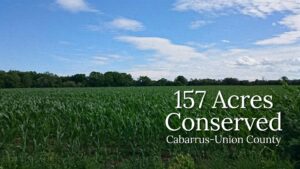
by Crystal Cockman
March 29, 2018

This past weekend, I had the opportunity to go out with a friend and some big tree hunters. Todd Pusser, marine biologist and wildlife photographer, introduced me to Byron Carmean, a retired biology and horticulture teacher, and Gary Williamson, a retired park ranger. They are big tree hunters extraordinaire. They’ve discovered more than 40 national champion trees, and they’ve nominated more trees to the American Forests Champion Trees national register than any other big tree hunters in the history of the program. American Forests maintains the national register of Champion Trees and works to protect the forests where our champions live. John Bunch also joined us.
Byron and Gary found a bald cypress in Virginia that was over 1,000 years old and was the biggest tree in the state at the time. This find was in the middle of 37 acres of virgin forest, surrounded by logging operations, and they helped preserve this tract, now known as Cypress Bridge Swamp Natural Area Preserve.
To measure a champion tree, you start by measuring the circumference of the tree at 4 ½ feet (Breast Height, BH) above the ground. If a tree forks immediately above BH causing significant swell just below the fork, circumference is measured at the narrowest portion of the stem below the swell. If a tree forks below BH, the larger stem is measured at BH. If there is a lot of duff or roots, you can back away from the tree a ways and pull a line to the tree to measure. For buttressed trees such as cypress or tupelo where swell may extend for several feet off the ground, circumference is measured at 1.5 feet above the pronounced swell. If a tree occurs on sloping ground, circumference is measured at BH from the uphill side of the tree. If a tree has appreciable lean, circumference is measured not at 4.5 feet above the ground, but 4.5 feet along the stem.
You then measure total height. Total height to the nearest foot is measured with a clinometer. For leaning or crooked trees, height measurements are taken at right angles to the direction of lean. Furthermore, one end of the measuring tape (used to measure the distance for the clinometer reading) is held directly under the tallest point of the tree.
Lastly, you measure crown spread. Average crown spread is measured to the nearest foot with a tape measure. Two measurements are taken in perpendicular directions (accounting for the widest and narrowest diameter of the crown) and averaged. A clinometer with a degree scale can be used in order to ensure measurements are taken directly under the outer perimeter of the crown. For more information, see http://ncforestservice.gov/urban/pdf/Howtomeasureachampiontree.pdf

The group measured a new national champion longleaf pine tree in Black Ankle in Montgomery County on Saturday morning before I met up with them. Andy Walker, botanist with the U.S. Forest Service on the Uwharrie National Forest, originally brought this tree to their attention. The tree is on private land and they owners have had the property for a number of years.
When I met up with the group, we went out to check out a chestnut oak in Randolph County. This was on a property that adjoins the Birkhead Wilderness Area that the landowner was gracious enough to let us explore. That tree, while large, was a couple feet shy of the state champion.

We then headed to Pee Dee National Wildlife Refuge in Anson County to check out a loblolly pine tree that J.D. Bricken, the refuge manager, had shown me a few years ago. It is a really massive tree, but it was just a few points shy of the state champion. They found a few other big trees, a nice willow oak and a cherrybark oak and an overcup oak, but none were large enough to rival the current champions.
They were headed to Raven Rock State Park the next day to see what other big trees they can find. I look forward to hearing what they found. If you know of other really large trees, we’d love to hear about them. Contact me at crystal@landtrustcnc.org or 704-647-0302. An oak tree of most any species needs to be at least 20 feet in circumference to even be considered as a possible champion. A large pine needs to be at least 10 feet in circumference. A few trees the group was keeping their eye out for were poison sumac, bladdernut, hornbeam, and hop hornbeam. You never know when you might find a state or national champion tree nearby.